Recent Water Damage Posts
The Basic Categories of Water
6/25/2019 (Permalink)
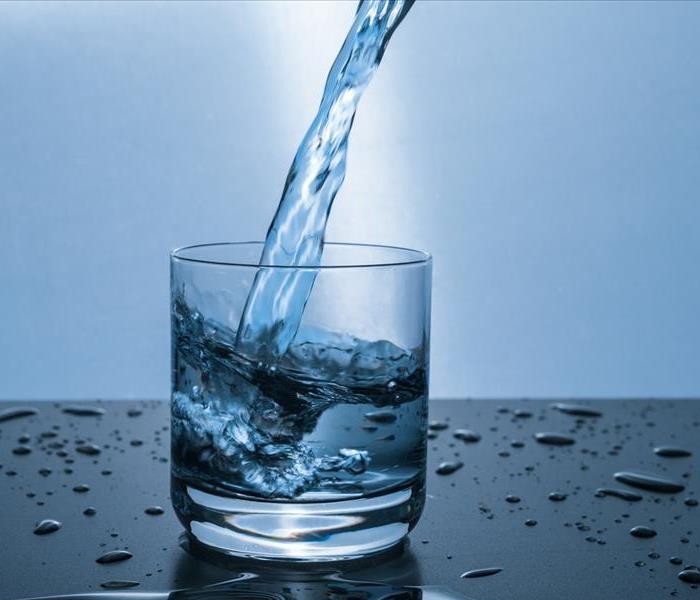 The 3 basic categories of water help explain the severity of a water damage situation.
The 3 basic categories of water help explain the severity of a water damage situation.
The 3 Basic Categories of Water
Category 1: White/Clean Water
The water stems from a clean source and poses no substantial risk from contact, ingestion, or inhalation. However, it can develop in another category if it comes into contact with other surfaces or materials. Typically, Category 1 water will evolve into Category 2 after 24 hours if left untreated.
Category 2: Grey Water
Grey water is contaminated water that doesn’t contain sewage. It may still contain some contaminates and has the potential to cause illness if contacted or ingested. It may contain potentially dangerous levels of microorganisms or nutrients for microorganisms, as well as other organic or inorganic matter (chemical or biological). Grey water can arise from sources such as a sink, washing machine, or the shower. Grey water can be used on your lawn or garden but if left unattended for 48 hours it can become Category 3.
Category 3: Black Water
Black water contains sewage or has encountered fecal matter. It is grossly contaminated and may contain pathogenic bacteria or other harmful agents. Such water sources may carry silt, organic matter, pesticides, metals, or toxic organic substances.
Time and temperature can also affect the quality of water and change its category.
*Refer to the IICRC S500 for complete definitions.
SERVPRO of Calgary South is equipped and ready to handle any water situation. Please call anytime 403-255-0202
Keep Your Home Safe This Winter: Cold Weather Housekeeping Tips
2/27/2019 (Permalink)
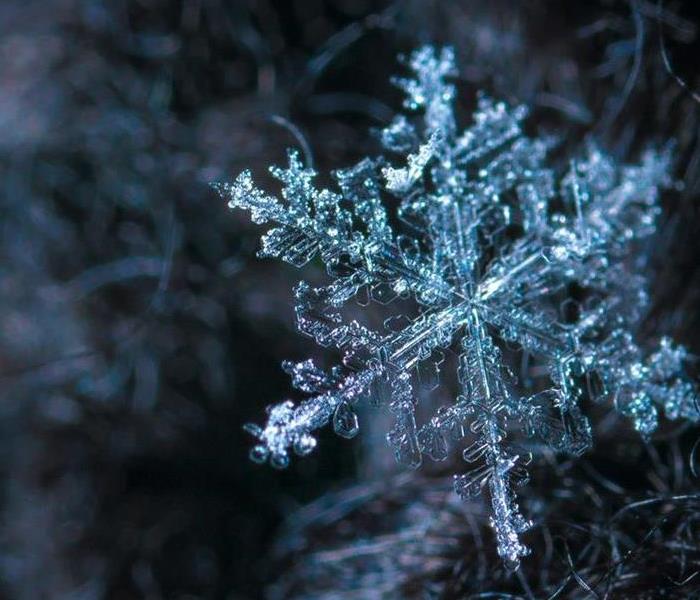 Cold winter weather tips and tricks
Cold winter weather tips and tricks
Keep Your Home Safe!
Since the severe weather has made an appearance (and doesn't seem to be going anywhere) across the country, it's only right if we give you Awesome Tips on keeping your home and business safe!
Tips for Preparing Your Home for Winter Weather
- Keep cabinet doors open during cold spells. This allows warm air to circulate around pipes
- Keep a slow trickle of water flowing through faucets, especially if the pipes for faucets, especially if the pipes for faucets run through unheated or un-insulated areas of your home.
- Consider shutting off outdoor faucets. Find the shut-off valve in the basement or crawl space and turn it to "off".
- If you follow the previous step, then open the outdoor faucet to help ensure it drains completely and the inner valve is shut off.
- Remove any attachments (hoses or sprinklers) from outdoor faucets, water can build up behind the attachment and freeze
- Ensure gutters are clean and secure. Leaves and debris accumulate, causing a damming effect on gutters, which could lead to roof problems and water damage.
- Proper maintenance of your furnace can help reduce the risk of puff backs.
If you follow these tips, especially on those extreme cold days, your home will stand a better chance against the cruel and cold winter weather.
Cold Winter Weather Help: Why Pipes Burst and Why it's Important
2/27/2019 (Permalink)
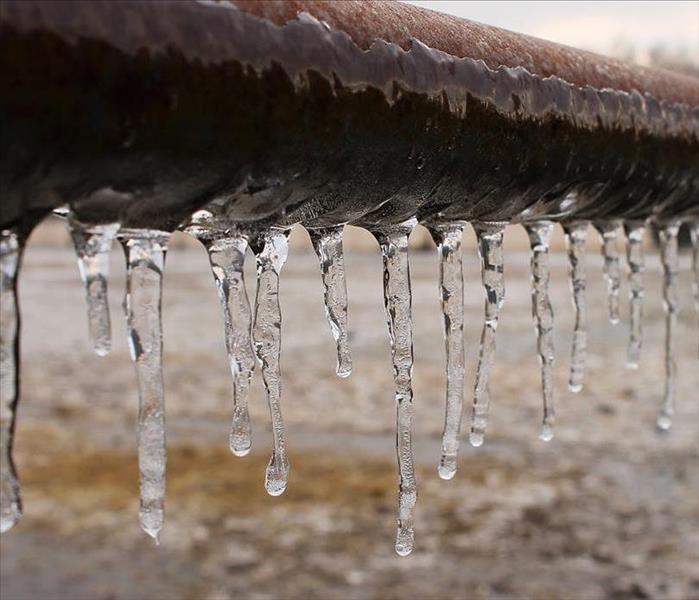 A frozen pipe can burst and cause a lot of damage to any home
A frozen pipe can burst and cause a lot of damage to any home
When water freezes, it expands. That’s why a can of soda explodes if it’s put into a freezer to chill quickly and forgotten. When water freezes in a pipe, it expands the same way. If it expands enough, the pipe bursts, water escapes and serious damage results.
WHY PIPES BURST?
Surprisingly, ice forming in a pipe does not typically cause a break where the ice blockage occurs. It’s not the radial expansion of ice against the wall of the pipe that causes the break. Rather, following a complete ice blockage in a pipe, continued freezing and expansion inside the pipe causes water pressure to increase downstream between the ice blockage and a closed faucet at the end. It’s this increase in water pressure that leads to pipe failure. Usually the pipe bursts where little or no ice has formed. Upstream from the ice blockage the water can always retreat back towards its source, so there is no pressure build-up to cause a break.
Water has to freeze for ice blockages to occur. Pipes that are adequately protected along their entire length by placement within the building’s insulation, insulation on the pipe itself, or heating, are safe.
MITIGATING THE PROBLEM
Water freezes when heat in the water is transferred to subfreezing air. The best way to keep water in pipes from freezing is to slow or stop this transfer of heat. Ideally, it is best not to expose water pipes to subfreezing temperatures, by placing them only in heated spaces and keeping them out of attics, crawl spaces and vulnerable outside walls. In new construction, proper placement can be designed into the building. In existing houses, a plumber may be able to re route at-risk pipes to protected areas, although this may not be a practical solution. If the latter is the case, vulnerable pipes that are accessible should be fitted with insulation sleeves or wrapping (which slows the heat transfer), the more insulation the better. It is important not to leave gaps that expose the pipe to cold air. Hardware stores and home centers carry the necessary materials, usually in foam rubber or fiberglass sleeves. Better yet, plumbing supply stores and insulation dealers carry pipe sleeves that feature extra thick insulation, as much as 1 or 2 inches thick. The added protection is worth the extra cost.
LETTING THE WATER RUN
Letting a faucet drip during extreme cold weather can prevent a pipe from bursting. It’s not that a small flow of water prevents freezing; this helps, but water can freeze even with a slow flow. Rather, opening a faucet will provide relief from the excessive pressure that builds between the faucet and the ice blockage when freezing occurs. If there is no excessive water pressure, there is no burst pipe, even if the water inside the pipe freezes. A dripping faucet wastes some water, so only pipes vulnerable to freezing (ones that run through an unheated or unprotected space) should be left with the water flowing. The drip can be very slight. Even the slowest drip at normal pressure will provide pressure relief when needed. Where both hot and cold lines serve a spigot, make sure each one contributes to the drip, since both are subjected to freezing. If the dripping stops, leave the faucet(s) open, since a pipe may have frozen and will still need pressure relief.
The Insurance Institute for Business and Home Safety have a full article HERE
If you notice a pipe burst, call a plumber immediately to have your water turned off. Any resulting leaks or water damage can be be handled by your friendly neighbourhood SERVPRO.
SERVPRO of Calgary South 24/7 Water Damage Response
2/20/2019 (Permalink)
Title: Calgary 24 Hour Emergency Water Damage Service
Category: Water Damage
Body:
SERVPRO of Calgary South is available 24 hours a day for water emergencies, large or small. When you are dealing with water damage, immediate action is crucial. A delay of just a few hours can greatly increase the severity of the water damage.
We Answer the Phone Ready to Help
Call Today (24/7) 403-255-0202
We understand that when you call us, you may be feeling confused, stressed, and vulnerable. You need an expert to guide you through this crisis. SERVPRO of Calgary South has the specific water damage training and experience to help you through this tough time. We specialize in water damage restoration—in fact, it's the cornerstone of our business.
What to Expect
When you call, we will ask several questions regarding your water damage emergency. These questions will help us determine what equipment and resources to bring, including how many trained SERVPRO Professionals may be needed.
Our SERVPRO Representative will ask several questions:
- Your name and contact information
- Your insurance information (if applicable)
- The street address of the water-damaged home or business
- When did the flooding or water damage occur?
- What caused the water damage (if known)?
- Is there electricity available (on-site)?
About SERVPRO of Calgary South
SERVPRO of Calgary South specializes in the cleanup and restoration of residential and commercial property after a fire, smoke or water damage event. Our staff is highly trained in property damage restoration. From initial and ongoing training at SERVPRO’s corporate training facility to regular IICRC-industry certification, rest assured our staff is equipped with the knowledge to restore your property.
Meet our Team:
https://www.SERVPROcalgarysouthab.com/employee-photos
Faster to your Calgary Water Damage Event
4/29/2018 (Permalink)
Flooding and water emergencies don’t wait for regular business hours and neither do we. SERVPRO of Calgary South provides emergency cleaning and restoration services 24 hours a day, 7 days a week—including all holidays.
Faster To Any Size Disaster
Flooding and water damage is very invasive. Water quickly spreads throughout your home and gets absorbed into floors, walls, furniture, and more. SERVPRO of Calgary South arrives quickly and starts the water extraction process almost immediately. This immediate response helps to minimize the damage and the cleaning and restoration costs.
Need Emergency Service? Call Us 24/7 at 403-255-0202
Water Damage Timeline
Within Minutes:
- Water quickly spreads throughout your property, saturating everything in its path.
- Water is absorbed into walls, floors, upholstery, and belongings.
- Furniture finishes may bleed, causing permanent staining on carpets.
- Photographs, books, and other paper goods start to swell and warp.
Hours 1 to 24:
- Drywall begins to swell and break down.
- Metal surfaces begin to tarnish.
- Furniture begins to swell and crack.
- Dyes and inks from cloth and paper goods spread and stain.
- A musty odor appears.
48 Hours to 1 Week:
- Mold and mildew may grow and spread.
- Doors, windows, and studs swell and warp.
- Metal begins to rust and corrode.
- Furniture warps and shows signs of mold.
- Paint begins to blister.
- Wood flooring swells and warps.
- Serious biohazard contamination is possible.
More Than 1 Week:
- Restoration time and cost increase dramatically; replacing contaminated materials and structural rebuilding may be extensive.
- Structural safety, mold growth, and biohazard contaminants pose serious risks to occupants.
About SERVPRO of Calgary South
SERVPRO of Calgary South specializes in the cleanup and restoration of residential and commercial property after a fire, smoke or water damage event. Our staff is highly trained in property damage restoration. From initial and ongoing training at SERVPRO’s corporate training facility to regular IICRC-industry certification, rest assured our staff is equipped with the knowledge to restore your property.
Water Damage in a Nutshell
8/24/2016 (Permalink)
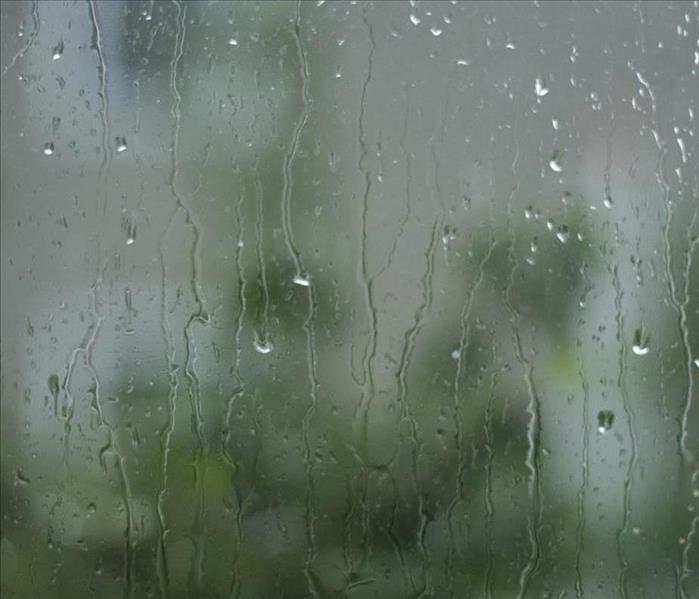 A wet and rainy season in Alberta.
A wet and rainy season in Alberta.
Preventing water damage will save you many headaches and is easier than dealing with the cleanup and repairs. We do not like to think about it, but water damage can cause severe damage to your property. It weakens the foundation and the very core that holds your property together.
You have heard about core strength in your body. Well, water damage hits at the core strength of your house, eventually causing severe structural damage. Damp wood invites termites and carpenter ants; plus, it causes mould and mildew.
Here are 3 easy prevention tips
These tips are easy things to do that will give you piece of mind the next time heavy storms hit.
- Ensure Good Drainage
Poor drainage weakens your foundation, causing cracks, uneven settling, and pathways for water to enter your home.
- Clean your gutters routinely. A clogged gutter and drains will send cascades of water down the side of your house, damaging your siding and foundation.
- Ensure your downspouts direct water 5 to 10 feet away from your house.
- Make sure your yard is sloped at least 6 inches over a 10-foot span away from your foundation.
- Check for Water Leaks
Persistent leaks lead to mould, mildew, rot, and even termites and carpenter ants (they like chewing wet wood, since it is soft).
- Check for dark spots under pipes inside sink cabinets, stains on ceilings, toilets that rock, and of course drips.
- At least once a year, inspect your roof. Repair any missing, loose, and or damaged shingles.
- Repair any cracked caulking and check for leaks around flashing.
- Know what to do should water damage occur
Water damage is all about action. Acting fast will save you time and unnecessary costs. Contact SERVPRO experts immediately will help our team to restore rather than replace. What you can do until SERVPRO arrives
- Remove art objects to a safe, dry place & gather loose items from floors.
- Remove coloured rugs and upholstery from wet carpeting to prevent stains.
- Do not turn on ceiling fixtures if the ceiling is wet, and keep out of rooms where ceilings are sagging. More tips here: http://www.SERVPROcalgarysouthab.com/water-damage-tips
SERVPRO Alberta Emergency Contacts
Calgary: 403.255.0202 | Edmonton: 780.784.7777
Alberta Flood Preparation
6/29/2016 (Permalink)
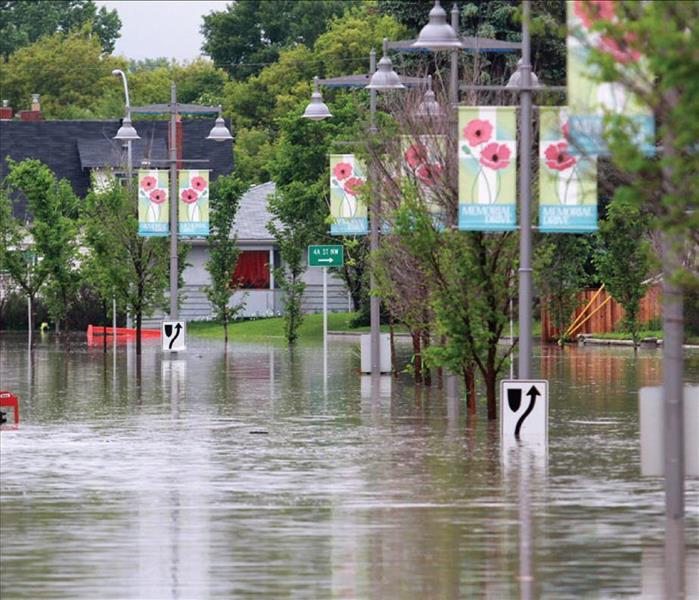 Alberta Flood
Alberta Flood
Some are calling Alberta the “natural disaster capital” of Canada after a study commissioned by the Insurance Bureau of Canada shows that an increase in extreme weather is hitting Alberta insurance companies pretty hard. Not only does this cause a financial burden for families and businesses owners, the livelihood of communities across the province are being affected. Wildfires, floods, hail storms, and other extreme weather conditions continue to sweep in each year causing millions of dollars in damage. Question is, what can we expect moving forward and how can Albertans protect themselves?
Don Forgeron, the President and CEO of Insurance Bureau of Canada made a speech in November of 2015 discussing the dire need of a National Flood program. Forgeron says “A national flood program, we believe, would offer a much more comprehensive and disciplined way to compensate people as a result of damage from flood.” This program would include new sewer and stormwater infrastructures around flood prone areas, create a “culture of flood preparedness” providing a comprehensive list of steps on how to flood proof their properties.
Will this National Flood Program move forward? We will have to wait and see. In the meantime, homeowners/property owners should take all the steps necessary to flood proof their homes and properties. Some of which include the following.
- Know if your home is built on Fill, clay, sand, or gravely soil as these materials can help prevent flood damage.
- Do you have an option to build elevated structures (columns or bearing walls) around your properties or more specifically the areas prone to flood damage?
- Observe the kind of materials of the structure of your house and make sure that it is properly sealed.
- Purchasing sandbags in the event of a flood are a great emergency tool to help prevent water from flowing into your home or property.
While all of these measures will help prevent severe damage in the event of a flood, home owners/property owners should still be educated about their insurance policies should they live in an area prone to flooding. Contact you Insurance company and educate yourself what kind of coverage you have and what is available.
As for a new national flood program, we will have to wait on new developments. Brenda Neufled reports that “IBC is proposing a framework for the financial management of flood risk, with shared responsibilities for the insurance industry, all tiers of government and consumers.” This could mean good news for Albertans living in flood plan areas. Keep an ear out as new aid might be available in the near future for those affected by floods or potential flood victims.
Prevent Frozen Pipes this Winter
12/1/2014 (Permalink)
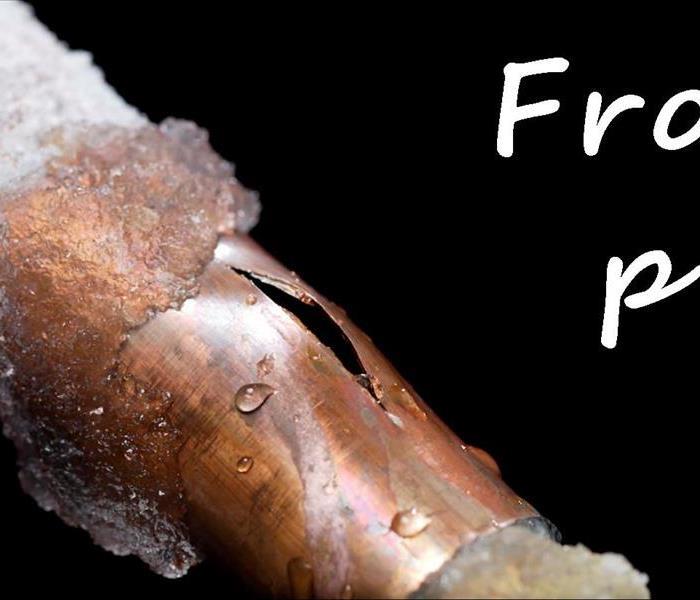 Prevent water damage this winter & stop pipes from freezing.
Prevent water damage this winter & stop pipes from freezing.
Frozen pipes are a leading cause of water damage in the colder months of the year. Why?
Water has the unfortunate property in that as it freezes, it expands. This can affect all types of water lines, whether metal, plastic, or PVC. Simply, all pipes are subject to bursting given the right amount of pressure. As the water freezes, it can expand the pipe, eventually causing a hairline crack or a complete break. At that point the portion unfrozen will then provide a continual stream of water until shut off, causing water damage throughout the property.
How can I prevent my pipes from freezing or bursting?
If possible, make sure that all pipes and supply lines on exterior walls are insulated. Exterior walls will be much colder than interior walls given their location. Additionally, all water lines in basements and crawlspaces need to be insulated as they will be subjected to very cold temperatures. Simple foam insulation wrap can help prevent your pipes from freezing.Make sure all outdoor hoses are removed from exterior hose bibs.Always keep your heating unit on and operational, even when away on vacation. If leaving for an extended period of time, set your thermostat to no colder than 55 degrees to ensure that your home has enough heat to properly keep interior pipes from freezing.Keep garage doors closed if you have water supply lines located in that area. In extreme cases of sever cold for extended periods of time, ensure that exposed pipes are insulated. Space heaters (placed away from anything flammable) can provide heat and warmth to combat cold environments in garage areas.If you notice very low water pressure from water supply areas, a frozen pipe could be the cause. Immediate action should be taken to identify the problem.What should I do if my pipes are already frozen?
Turn on all the faucets with warm water, not hot, to a slow drip. This will help in supplying warmer water to the area without causing an abrupt temperature change. It will also help you in determining the location of the freeze.Apply exterior heat to the frozen section of pipe. This can be done with a hair dryer, electric heating pad, space heater, and towels soaked in warm water wrapped around the pipe. NEVERuse open flame devices, as this can be a major fire hazard.Keep continual heat on the area until water flow is restored to normal.Once restored, try to determine why the area froze. It may be as simple as adding insulation, sleeve wraps, UL listed heat tape, or other form of insulation.If you cannot locate, find, or properly thaw your pipes, call a professional plumber to assist.What if my pipes burst and caused damage?
If your pipes have busted, cracked, or began leaking, immediate action should be taken to ensure that water damage could be minimalized to you property. Soak up as much water as possible with towels or extract with a shop vac. It's often necessary to have professionals like SERVPRO come in and completely mitigate the water. Home drying efforts can help reduce damages, but will not get rid of all moisture and humidity. It's important to ensure that your property is completely dry and dehumidified to prevent secondary damage from ruining your home, flooring, furnishings, or building materials. Call SERVPRO today if you've had water damage from a pipe leak, and we'll work with you and/or your insurance company to make sure that your home is restored correctly!




 24/7 Emergency Service
24/7 Emergency Service





